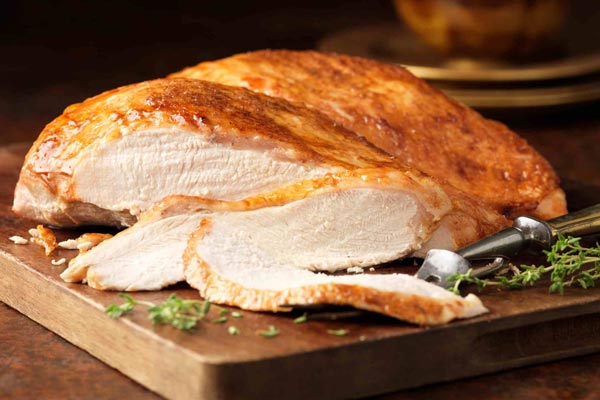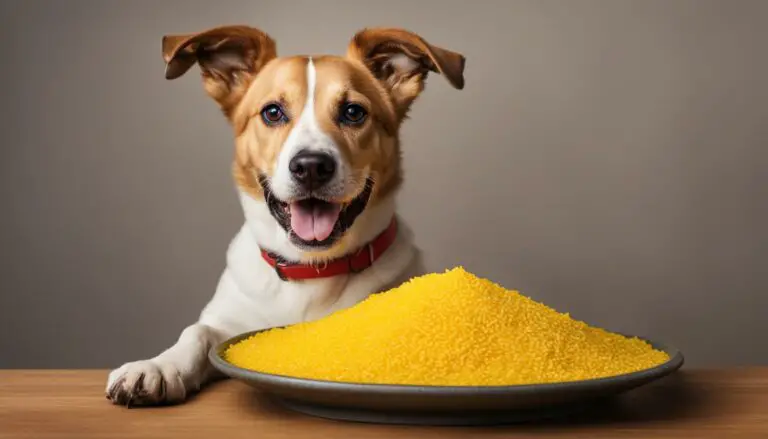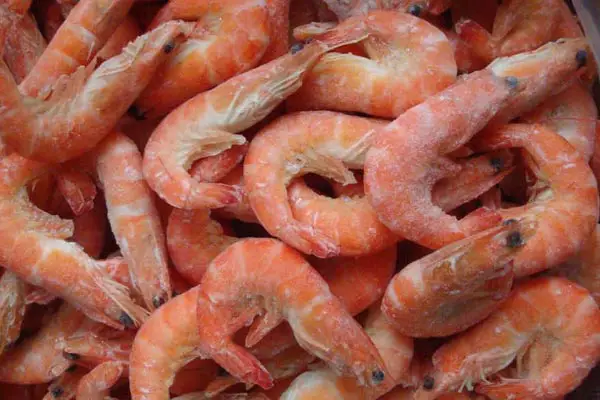All the Facts About Whether Dogs Can Eat Turkey
Every Thanksgiving, over 45 million turkeys are eaten each year. Eaten by people, that is. But how about man’s best friend? Should you pull up a seat for your dog at the Thanksgiving Day dinner table?
You might be curious as to whether it’s OK to feed turkey to dogs. The answer seems like it would be a simple ‘yes’ or ‘no’, but in reality, it’s a little bit more complicated than that. The following will give a detailed overview about feeding turkey to dogs.
Can Dogs Eat Turkey?
The simplest answer to this question is yes. Turkey is meat, and dogs are descended from animals who were meat eaters in the wild. And to this day, meat and meat products make up a large part of a dog’s ideal diet.
According to PetMD, turkey is found in many dog foods. You’ll frequently see an ingredient like ‘turkey meal’ on the side of a bag of dog food.
So, to answer the simplest form of the question, dogs can absolutely eat turkey, and do all the time.
Is Turkey Healthy For Dogs?
Turkey is a lean protein, similar to chicken. As a protein, turkey helps dogs build and maintain muscle, and is a highly digestible food source for a dog.
Turkey can be a good alternative for certain dogs who have allergies or food sensitivity toward chicken. As chicken is a prominent ingredient in many dog foods, a dog who can’t safely process chicken may find that turkey-based foods are the best choice.
In the right context and the right form, turkey is very healthy for dogs.
Can Turkey Be Harmful to a Dog?
But here’s the catch: not all turkey is 100% healthy for dogs. You wouldn’t want to go carving a slice off the Thanksgiving turkey and giving it to your family dog.
Humans do a lot to the season and prepare their food, adding butter, onions and garlic, spices and other extra ingredients to the turkey during the cooking process. While the turkey meat itself is harmless for a dog, some of those additives aren’t so good.
For instance, let’s take the buttered turkey is often cooked with. According to the American Kennel Club, many dogs are lactose intolerant and don’t process dairy foods well.
Any dairy (including butter) can lead to diarrhea, vomiting and abdominal pain for your dog. And even if the dog isn’t lactose intolerant, dairy products are high in fat and can lead to canine obesity.
Similarly, dogs aren’t built to handle garlic and onions. According to PetMD, both these foods are hazardous to a dog.
In small quantities, most dogs will not show any significant effect, but garlic and onions are not foods you want to be giving to your dog. The same is true for many spices we use to season our food.
Overall, human food tends to be on the fatty side. Feeding a dog a high-fat diet can have some very negative ramifications over time.
Can Eating Turkey Make a Dog Sick?
One possible adverse health condition a dog can suffer as a result of eating human food is Pancreatitis. Pancreatitis is an inflammation of the pancreas. It’s a serious condition that can cause any of the following.
- Vomiting, especially repeated vomiting
- Loss of appetite
- Diarrhea
- Pain or swelling in the abdomen
- Dehydration
- Fever
- Weakness or your dog seems tired all the time
According to the American Kennel Club, one of the primary causes of Pancreatitis in dogs is a diet high in fat. Very frequently, this means a dog who is eating a lot of human food.
If you’re feeding your dog turkey that has been prepared for people to eat, there’s a decent chance that it’s high in fat and prepared with foods that don’t mix with dogs’ digestive processes. As a result, you should be very careful about feeding that type of turkey to your dog.
Another big no-no is feeding your dog the skin from the turkey. Some people love to snack on the skin of a roast turkey but resist the urge to share with your dog. Turkey skin is extremely high in fat, so the risk of Pancreatitis goes up.
What Kinds of Turkey are Best for Dogs?
The closer turkey is to its natural state, the better it is for a dog. While eating a bland and unseasoned piece of cooked turkey might not sound appealing to us, your dog will absolutely love it.
The key to preparing the turkey for your dog is not to think like a human and try to dress the flavor up with the addition of any seasonings or extra ingredients. Simply boiling, baking or grilling turkey until it’s cooked through is all you need to do.
Is Turkey Breast Good for a Dog?
Boneless turkey breast can be a perfectly good meal for a dog. Again, the key is not to ‘enhance’ the meal, but just to cook the turkey breast through and chop it up for the dog to eat.
A turkey breast with the bone in is a different story. We’ll discuss that later, but for now, it’s enough to know that you shouldn’t give a dog a bone-in piece of turkey.
Is Ground Turkey Good for a Dog?
Like a boneless turkey breast, ground turkey is perfectly fine for a dog, with the same caveat about not seasoning it applying. In fact, ground turkey is probably the closest to what actually appears in dog food.
Ground turkey sold for human consumption will be of a higher quality and have more health-related restrictions surrounding its production than turkey appearing in dog food. But in terms of substance, it’s pretty much the same thing.
Is Turkey Lunch Meat Good for a Dog?
A piece of lunch meat here or there isn’t going to cause major problems for a dog. Lunch meats like processed turkey contain more sodium than dogs would normally eat in their diets, but the effects of that aren’t dramatic unless the dog is eating way too much human food high in sodium.
However, feeding a dog exclusively on turkey lunch meat (or any other lunch meat) would be a bad idea. Dogs need nutrients that simply can’t be found in processed lunch meats.
What is the Safe Way to Feed a Dog Turkey?
To feed your dog turkey in a way that’s safe for your dog, follow these instructions and tips:
Cook the Turkey Meat Before Serving it
Make sure to cook any turkey you feed your dog thoroughly. There’s a misconception that because animals eat raw meat in the wild, that means they could eat raw meat purchased from a grocery store or butcher’s shop.
Here’s the problem with that line of thought, though: the meat dogs would be eating in the wild isn’t the same as the meat we buy from the store.
In the wild, a dog would be killing a prey animal and then eating it immediately. In contrast, the meat that we buy in the store has been dead for days in some cases.
During that time it’s been processed and transported, there’s a steadily increasing chance that some kind of bacteria or pathogens has begun to develop in it.
Not to mention, turkey meat raised and processed through factory farming has added risk because turkeys are kept in close quarters with hundreds of their fellow turkeys, meaning more chance of infections spreading.
Just like you wouldn’t eat a piece of raw turkey yourself, don’t give one to your dog.
No Need to Season or Enhance the Flavor of Turkey as You Prepare It
We’ve been over this one before. Your dog will go crazy for plain, unseasoned turkey.
Remove All Bones and Skin From Turkey Before Feeding it to Your Dog
This is a big one. We’ve already discussed how feeding a dog turkey skin can increase the risk of Pancreatitis. But removing all bones before feeding turkey to your dogs is far more important.
Cooked turkey bones represent a clear and present danger to your dog. To understand why it’s necessary to understand the difference between raw turkey bones and cooked ones.
It comes back to that same mistaken assumption people make in feeding raw meat to their dogs. In the wild, dogs and other carnivores periodically eat and swallow bones.
But the small bones of most littler prey animals (including chicken and turkey) are flexible and soft when they’re raw. Dogs and other predators can chew them up and pass them through their system.
When turkey bones are cooked, though, they become brittle and dry. When your dog chews on them, they’re prone to fragmenting into small pieces, which can be very hazardous.
According to the American Kennel Club, eating cooked turkey bones can result in
- Injuries to the mouth and tongue
- Choking and obstruction of the digestive tract
- Bone fragments cutting or piercing the stomach or intestines
- Constipation due to obstruction of the intestines
- Bleeding from the rectum while passing bone fragments
- Digestive tract blockages requiring immediate surgery
A Turkey Based Homemade Dog Food Recipe
Here’s a Youtube video showing how to make a homemade dog food using turkey. This shows how to safely prepare the turkey and integrate it into a recipe both safe and tasty for your dog.
You can follow the directions here if you want to experiment with making turkey-based food for your dog.
What to do if a Dog Swallows a Turkey Bone
According to the American Kennel Club, the first thing to do if your dog eats a turkey bone is to observe your dog. Does he or she appear to be in any distress? Is there any bleeding in the mouth region?
If your dog seems to be in noticeable discomfort or is having trouble breathing, you may need to take him or her into the vet, as this could mean a broken turkey bone is causing major problems internally, or that the bone is lodged in your dog’s throat.
If your dog isn’t in immediate pain or discomfort, you’ll need to continue to monitor him or her closely over the next few days.
Pay attention to his or her stools, both that they’re happening and to see if any bone fragment is passing. If your dog isn’t defecating, there may be a blockage in the intestine, which could require surgery.
Similarly, if you don’t see any bone fragments over the next three days, that turkey bone may be caught somewhere in the digestive tract.
Finally, feed your dog soft foods over those next couple of days. The soft foods can help cushion the bones as they pass out of your dog’s digestive system.
How Much Should Turkey a Dog Eat?
Consult with your veterinarian when planning a meal regimen for your dog including turkey. The amount of turkey your dog should be eating varies based on how big your dog is and how much it weighs.
A vet will be able to help you plan a diet for your dog that gets him or her all the nutrients needed and keeps any weight gain under control.
What are Some Alternatives to Feeding a Dog Turkey?
The most obvious alternative to turkey out there for your dog is chicken. The two types of meats are almost identical in terms of the nutrients they provide your dog and the health and safety factors.
Pretty much any advice given about feeding turkey to dogs will apply for chicken as well. There are some dogs who have a food sensitivity to either chicken or turkey, in which case one is suitable for that dog and the other isn’t. Other than that, chicken is a seamless alternative.
Beyond chicken, other types of meat like beef or sheep are acceptable. However, those meats aren’t as lean as turkey, so be careful about portions if you’re substituting red meat for turkey.






